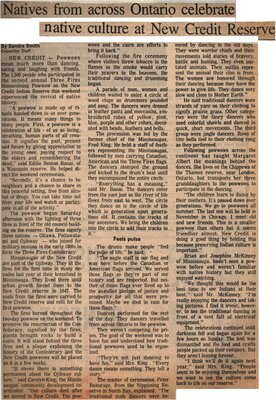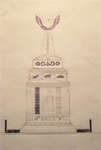"Natives From Across Ontario Celebrate Native culture at New Credit Reserve"
- Publication
- Brantford Expositor, Summer 1988
- Full Text
- Natives from across Ontario celebrate native culture at New Credit ReserveBy Sandra Smith Expositor Staff
NEW CREDIT - Powwows mean much more than dancing, eating and laughing with friends. The 1,500 people who participated in the second annual Three Fires Homecoming Powwow on the New Credit Indian Reserve this weekend experienced the revival of native history.
"A powwow is made up of rituals handed down to us over generations. It means many things to many people. First, a powwow is a celebration of life - of us as living, breathing, human parts of all creation. It signifies the past, present and future by giving appreciation to the young ones, paying respect to the elders and remembering the dead," said Eddie Benton Banai, of a Wisconsin reserve. He helped direct the weekend ceremonies.
"Secondly, it's a chance to be neighbors and a chance to share in this peaceful setting, free from alcohol or drugs. You can take time out from your life and watch or participate in all of the activity."
The powwow began Saturday afternoon with the lighting of three fires in front of the old council building on the reserve. The fires signify three nations - Ottawa, Pottawatami and Ojibway - who joined for military reasons in the early 1800s to form the Three Fires Confederacy.
Mississaugas of the New Credit are part of the Ojibway. They lit the fires for the first time in many decades last year at their homeland in Mississauga. They lived there until urban growth forced them to the New Credit reserve in 1847. The coals from the fires were carried to New Credit reserve and relit for the first powwow.
The fires burned throughout the two-day powwow on the weekend. To preserve the resurrection of the Confederacy, signified by the fires, guests brought rocks to build a cairn. It will stand behind the three fires and a plaque explaining the history of the Confederacy and the New Credit powwows will be placed on it in a few weeks.
"It shows there is something permanent about the Ojibway culture," said Carolyn King, the Mississaugas' community development co-ordinator. "Our culture died after we moved to New Credit. The powwows and the cairn are efforts to bring it back."
Following the fire ceremony where visitors threw tobacco in the flames so the smoke would carry their prayers to the heavens, the traditional dancing and drumming began.
A parade of men, women and children waited to enter a circle of wood chips as drummers pounded and sang. The dancers were donned in leather pants and moccasins, embroidered robes of yellow, pink, blue, purple and other colors, decorated with beads, feathers and bells.
The procession was led by the former chief of the Mississaugas, Fred King. He held a staff of feathers representing the Mississaugas, Fred King. He held a staff of feathers representing the Mississaugas, followed by men carrying Canadian, American and the Three Fires flags. The dancers stomped the ground and kicked to the drum's beat until they encompassed the entire circle.
"Everything has a meaning," said Mr. Banai. The dancers enter from the east just as the river of life flows from east to west. The circle they dance on is the circle of life which is generation upon generations old. It contains the tracks of our ancestors. We bring the children into the circle to add their tracks to it."
Feels pulseThe drums make people "feel the pulse of life," he said.
"The eagle staff is our flag and was here before the Canadian or American flags arrived. We served those flags so they're part of our history and are respected. But neither of those flags ever lived up to the so-called pledges of justice and prosperity for all that were promised. Maybe we died in vain for those flags."
Dancers performed for the rest of the day. They dancers travelled from across Ontario to the powwow.
They weren't competing for prizes. The goal of the weekend was to have fun and understand how traditional powwows used to be organized.
"They're not just dancing to have fun," said Mrs. King. "Every dance means something. They tell a story."
The master of ceremonies, Peter Beaucage, from the Nippissing Reserve in North Bay, explained: "The traditional male dancers were honored by dancing in the old days. They were warrior chiefs and their movements told stories of bravery, battle and hunting. They even imitated animals. Their outfits represent the animal their clan is from. The women are honored through their dancing because they have the power to give life. They dance very slow and close to Mother Earth."
He said traditional dancers wore strands of yarn on their clothing to signify prairie grass. Other categories were the fancy dancers who used colorful shawls and danced in quick, short movements. The third group were jingle dancers. Rows of tiny bells tied to their clothing rang as they performed.
Following powwows across the continent has taught Margaret Albert the meanings behind the dances. She lives on the Chippewa of the Thames reserve, near London, Ontario, but transports her three granddaughters to the powwows to participate in the dancing.
"The children learn to dance by their mothers. It's passed down over generations. We go to powwows all summer. The last one will be held in November in Chicago. I meet old and new friends. This is a smaller powwow than others but it seems friendlier almost. New Credit is doing a good thing by holding this because preserving Indian culture is important."
Brian and Josephine McKinney of Mississauga, hadn't seen a powwow before and weren't familiar with native history but they still enjoyed watching.
"We thought this would be the best time to see Indians at their best," said Mr. McKinney. "I'm really enjoying the dancers and taking pictures. I find it ironic, however, to see the traditional dancing in front of a tent full of electrical equipment."
The celebrations continued until darkness fell and began again for a few hours on Sunday. The tent was dismantled and the food and crafts people packed up their campers. But they aren't leaving forever.
"I think we'll do it again next year," said Mrs. King. "People seem to be enjoying themselves and we want to see the culture come back to life on our reserve."
- Creators
- Smith, Sandra, Author
- Smith, Christopher, Photographer
- Media Type
- Newspaper
- Item Types
- Articles
- Clippings
- Description
- "Powwows mean much more than dancing, eating and laughing with friends. The 1,500 people who participated in the second annual Three Fires Homecoming Powwow on the New Credit Indian Reserve this weekend experienced the revival of native history."
- Date of Original
- Summer 1988
- Subject(s)
- Personal Name(s)
- Banai, Eddie Benton ; King, Carolyn ; King, Fred ; Beaucage, Peter ; Albert, Margaret ; McKinney, Brian ; McKinney, Josephine.
- Local identifier
- SNPL002526v00d
- Collection
- Scrapbook #1 by Janet Heaslip
- Language of Item
- English
- Geographic Coverage
-
-
Ontario, Canada
Latitude: 43.00011 Longitude: -80.08295
-
- Creative Commons licence
 [more details]
[more details]- Copyright Statement
- Public domain: Copyright has expired according to Canadian law. No restrictions on use.
- Copyright Date
- 1988
- Copyright Holder
- Brantford Expositor
- Contact
- Six Nations Public LibraryEmail:info@snpl.ca
Website:
Agency street/mail address:1679 Chiefswood Rd
PO Box 149
Ohsweken, ON N0A 1M0
519-445-2954



